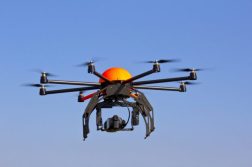Oregon UAV nonprofit hires director
The Oregon Unmanned Systems Business Enterprise, a new nonprofit designed to establish Oregon as a leader in the civilian uses of unmanned aerial systems, has named Mark Morrisson as its executive director.
Morrisson’s hiring culminates with the launch of the OR-UAS, which was created by Economic Development for Central Oregon. The organization’s goal is to create jobs and economic growth by capitalizing on the development of UAVs and their associated applications.
“In addition to the aviation component of UAS, there is real intellectual property value in the sensor technology and the data analysis that spins off from it,” said Rick Spinrad, vice president for research at Oregon State University and board president of OR-UAS. “We are fortunate to have in Mark an individual who comes from the sensor world, who has managed many complicated programs, and who has helped to launch a number of startup companies.”
Morrisson, who studied biochemistry and microbiology at the University of Queensland, Australia, most recently worked as senior director of corporate investment for Jabil Inc., a supply chain management and electronic manufacturing firm.
His background also includes a five-year stint as CEO of Universal Biosensors, an Australian medical diagnostics company, and four years as general manager of Sun Country Raft Tours, in Bend, Ore.
OR-UAS’s initial funding comes from a two-year, $882,000 state grant from the Oregon Business Development Dept. and the Oregon Innovation Council, which was approved by the 2013 legislature. OR-UAS seeks to match state funding with private investments, grants and other programs to get innovative projects off the ground.
Using seed money provided by this grant, OR-UAS seeks to:
- Expand existing Oregon companies that support UAS technology
- Assist Oregon companies in winning new contracts and grants
- Recruit UAS firms to test vehicles, sensors, systems and applications in the state and to establish offices and facilities here
- Generate industry-leading applications that promote innovation
Last month, Oregon, which partnered with Hawaii and Alaska, was named as the home of one of six UAV test sites by the Federal Aviation Administration, thanks in part to its ability to provide UAV testers with a diverse range of climates.
Nigel Ballard, Intel’s director of federal marketing and a member of the OR-UAS board, has been one of the state’s largest UAV champions.
“People have asked why I took a seat on the Oregon UAS investment board as my dance card is clearly already pretty full with my day job,” Ballard said in an email to StateScoop. “The simple answer is, I’m a big supporter of unmanned aerial vehicles as a means of performing a number of tasks, cheaper, more efficiently and noticeably quieter than could be achieved with a manned aircraft or helicopter.”
He continued: “Here in Oregon where I reside, there is a need for rural commercial investment and the employment that will surely follow. Not everybody needs, or wants, to live in the city. Add that to the desire for farmers and vineyards to economically track their livestock, crops and vines and you have the basis for a most synergistic UAS relationship. With the joint Alaska/Oregon/Hawaii FAA flight testing range award, we’re able to attract employment and provide a service to our growers. #winning.”
While UAVs have gotten plenty of attention for their military applications, there are a number of purposes for UAVs in the civilian marketplace, such as in agriculture and public safety.
Agriculture, in particular, is expected to be the focus of as much as 85 percent of the spending on this technology in the next few years. Agriculture represents the largest use of UAS in the world, and in these applications the United States trails many other nations.
Early studies show UAVs can add between 8 and 10 percent to the bottom line of farmers by reducing costs and improving yields. Oregon’s many specialty crops give the state an opportunity to lead the nation in a variety of agricultural applications.
“Many of these uses are on the cusp of commercial viability and represent great growth opportunities for companies in the state,” Morrisson said. “The technologies exist and the needs exist. What we require are specific projects that prove the cost-benefit advantages of UAS, that develop the proper processes for the particular use, and that demonstrate the flight safety required by the FAA.”





